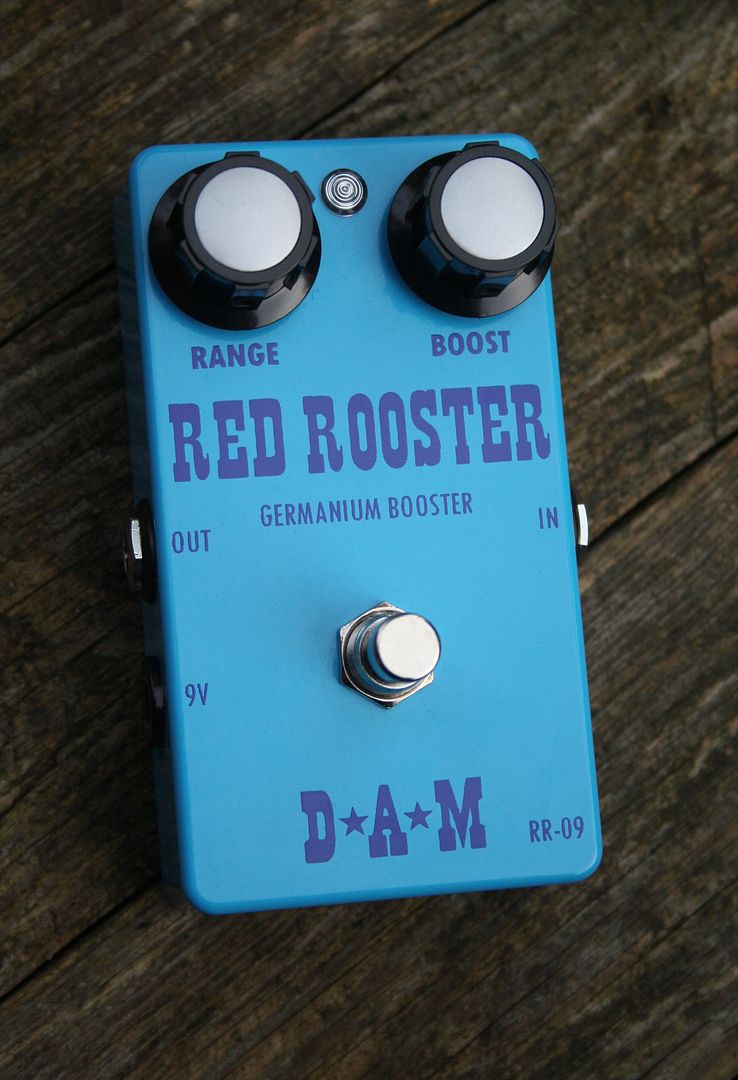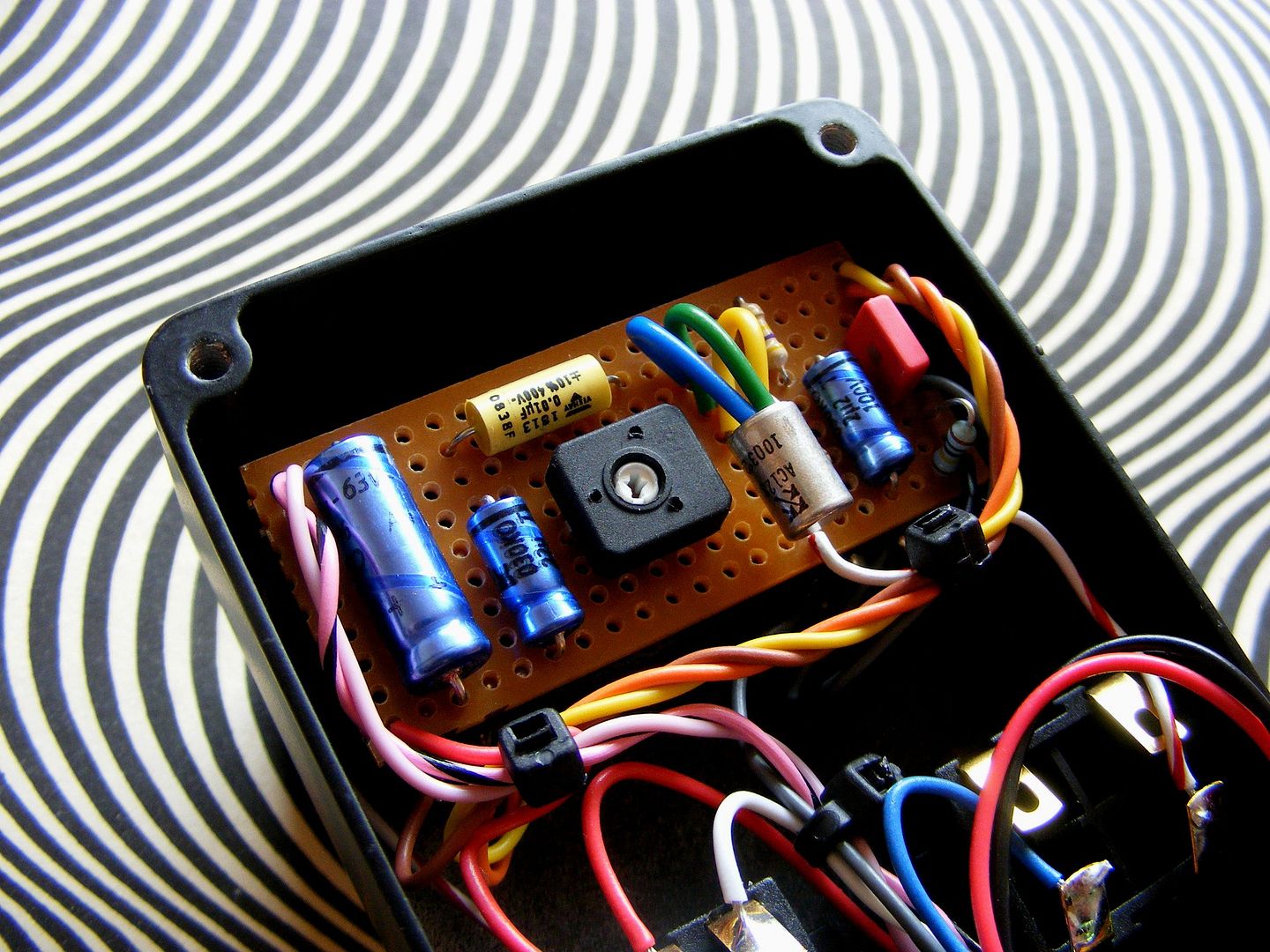The Dallas Rangemaster is probably one of the best known vintage effects out there. A simple germanium treble booster it was used throughout the 60's to boost the inputs of typically "dark" sounding British amps of the time to create a huge wall of overdriven valve tone. Used by a load of guitar greats for all sorts of signature tones. Here's some info from http://www.analogman.com/beano.htm:
"The [original Dallas Rangemaster] were not a pedal at all, but a tabletop unit with on/off switch and volume knob. The input jack was on the front and there was a built in cord on the back to plug into your amp. These are selling for very high prices, well over $1000, and much more with original boxes for collectors. Here's some trivia - the original Rangemaster was NOT true bypass, with the BOOST switch off, quite a bit of high-end is rolled off, like an old wah.
Eric [Clapton] is not the only one who used this effect for his tone - Brian May used one or a modified version on nearly all his guitar parts in Queen, which is how he got such a sweet tone out of his Red Special through walls of AC30s.
Billy F Gibbons seems to hold his Dallas Rangemaster in high regards, one of his Holy Grails.
Ritchie Blackmore of Deep Purple also used these quite a bit.
Tony Iommi of Black Sabbath was another heavy user of this effect - his SG's through Laneys got boosted to create the original HEAVY METAL rock guitar sound, a sound that still holds up today as one of the best tones ever."
As you can see the Rangemaster has been used by some top quality guitarists and produces a super sweet sound that is coloured by the germanium transistor that is used. Here's a quick demo video of the Rangemaster's tone:
Now here's the original Rangemaster schematic from Fuzz Central:
Now, if you want to build this circuit you'll need to take some precautions - DON'T use old carbon comp resistors - use high precision metal film resistors with max 1% tolerance (I try to use 0.1% tolerance metal film) and use 2% or lower accuracy capacitors if you can. Also make sure you use a highly regulated power supply. If you don't expect this thing to hiss like a pissed off snake on steroids - it's that type of circuit. For all the technical info you could ever want on the Rangemaster check out this article at R.G's Geofex: http://www.geofex.com/article_folders/rangemaster/atboost.pdf
In the article he offers some great tips for tuning your Rangemaster to perfection:
"I recommend you do the actual tuning this way:
1. Build up your circuit by one of the methods shown later. Leave the Rb1 [the 68k resistor] and Re [the 3k9 resistor] resistors out, attaching a 100K and a 10K pot respectively on long wires for each.
2. Use a DMM and set these pots to the nominal 68K and 3.9K respectively, and make a temporary mark on the pot and shaft to note the pot rotation at these values.
3. Apply battery voltage and measure the collector voltage to ground. You would like to see –6.6 to –7.2V with a fresh battery (9.0 to 9.3V).
4. If the collector is too high (the transistor is too “off”) increase the Rb1 value. If you go very near the highest resistance before you get to –7V, reset the Rb1 pot to the 68K mark and inch the Re value down a bit, then try tuning the Rb1 value again.
5. If you go near the low end of the Rb1 resistor before you get to –7V, increase the Re value slightly.
6. Once you get to –7V on the collector, turn it off , remove the pots, being careful not to turn the shafts. Measure the resistances and solder in the nearest standard value fixed resistors.
7. If Rb1 is below27K or above 82K, or if Re is below 2.7K or above 5.1K, your transistor either has the wrong gain or is too leaky to use, you’ll have to use another one
Once you have tuned the bias point, you may have to tweak the input capacitor, Cin [the 0.005uF cap]. This is nominally 0.005uF in the original Dallas Rangemaster. The exact frequency response of the very simple circuit depends primarily on the value of this capacitor and the input resistance of the transistor. In the originals I have seen, the input resistance of the transistor in parallel with the two biasing resistors tends to be about 12K, so a 0.005uF capacitor makes unity gain about 80 Hz, the frequency of the lowest note on a normally tuned six string guitar.
Note that some transistors will require Cin of as much as 0.0068uF. Full boost is around 1-2kHz. Minor variations of the transistor gain do affect this response somewhat, but don’t make a huge difference in the sound. If you make the capacitor smaller, the region of full boost moves up, but the gain at the lowest notes goes down, as the pass band of the Dallas Rangemaster moves away from it, so the sound gets subjectively thinner. If you make the capacitor bigger, the passband moved down, so progressively lower frequencies are boosted. If you make the input capacitor much larger, say as much as 0.15uF, then almost all notes are boosted to full gain, and the result is only the soft distortion on all notes, which you may prefer. This is NOT the original Dallas Rangemaster sound, but you may prefer it for your purposes. For the original Dallas Rangemaster sound, stay within about +/- 50% of 0.005uF."
Now, here's what I really want to look at; the D*A*M Red Rooster - It's an updated version of the Dallas Rangemaster:
Here's a description from the D*A*M website:
"Red Rooster - Germanium Booster. Want to drive your valve amplifier into natural overdrive? Create valve overload at low volume settings? Need a treble booster, a bass booster, and a multi purpose full frequency old school flavoured solo booster? Biggty Bam! Check out the D*A*M Red Rooster. Does all of the above and some. Works wonders in zinging up muddy sounding fuzz boxes and will make weak or low output guitar pick-ups warmer, more dynamic and fuller bodied. ...
1. True bypass switching. The Rooster is totally removed from the guitars signal when in bypass mode, it will not bleed through and dull your guitars original tone.
2. Features a 'Range' control so treble, full range and bass boost can be acquired. It also means it is well suited to either single coil or humbucking pick-ups of varying output and gain levels.
3. Uses a specially selected and tested high grade Mullard germanium transistor. Usually an OC71 or an OC45.
4. Adjustable biasing so that the germanium transistor is correctly set up to produce a bold, clear dynamic tone with a good amount of sustain.
5. Low noise circuitry using high grade Ero Vishay film capacitors, BC components Electrolytic capacitors and 1% tolerance metal film resistors.
6. A heavy duty cast aluminium enclosure finished in a highly durable powder coated paint job.
7. High quality passive components such as audio grade Omeg potentiometers, Daka-Ware control knobs and Neutrik jack sockets."
And a little demo video:
They do sound great and the build quality is second to none, check out this gut shot, neat as you like:
So here's a replica of that layout:
The Boost pot is 10KB and the Range pot is 100KB, the trim pot can be 5K or 10k and you use this to dial in the transistor bias (6.66v on the transistor collector - tune it to the number of the Beast...). You'll need an NPN germanium transistor with a Hfe ~ 100ish (select the Hfe to taste - higher = more grit!)
For an alternative vero layout (also verified) check out IVIark's great tagboardeffects: http://tagboardeffects.blogspot.co.uk/2011/11/dam-red-rooster-vero-layout.html
Finally here's the freestompboxes.org forum topic for reference: http://freestompboxes.org/viewtopic.php?f=7&t=4178






This comment has been removed by the author.
ReplyDeleteVERY GOOD
ReplyDelete